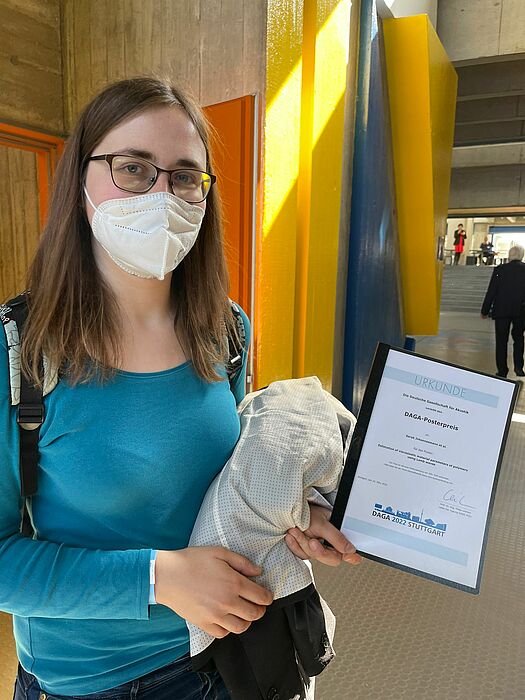Die 48. Jahrestagung für Akustik (DAGA 2022) ist in Deutschland mit ca. 1150 Teilnehmern die bedeutendste Konferenz auf dem Gebiet der Akustik und fand dieses Jahr vom 21. bis zum 24. März 2022 als Hybrid-Veranstaltung in Stuttgart statt. Bereits in guter Tradition, beteiligte sich auch dieses Jahr das Fachgebiet Elektrische Messtechnik und berichtete über aktuelle Forschungsergebnisse aus einigen von der DFG geförderten Forschungsprojekten.
Dr. Leander Claes stellte in seinem Beitrag "Identification of piezoelectric material parameters using optimised multi-electrode specimens" eine verbesserte Messmethode zur Bestimmung vollständiger und konsistenter Materialparametersätze für piezokeramische Bauelemente vor. Diese Forschungsergebnisse entstanden im Rahmen des von der DFG geförderten Projekts "Ein modellbasiertes Messverfahren zur Charakterisierung der frequenzabhängigen Materialeigenschaften von Piezokeramiken unter Verwendung eines einzelnen Probekörperindividuums" (DFG Projekt-Nr. 321120716), welches in Kooperation mit dem Lehrstuhl für Mathematische Optimierung der Humboldt-Universität zu Berlin bearbeitet wurde.
Identification of piezoelectric material parameters using optimised multi-electrode specimens
Autoren: Leander Claes, Nadine Feldmann, Veronika Schulze, Benjamin Jurgelucks, Andrea Walther, Bernd Henning
Due to the availability of computational resources, modern design processes of sensor and actor systems are becoming increasingly simulation-driven. A prerequisite of these processes is, however, that the materials used are well-known and described by a material model. For piezoceramic materials the parameters of such a model is especially hard to determine, as it includes mechanical, electrical, and piezoelectric quantities.
The authors have previously shown that a complete set of piezoelectric material parameters can be identified based on three electrical impedance measurements of a disc-shaped specimen with three ring electrodes. As a continuation of this work, a new electrode structure requiring only a single impedance measurement is determined by a simulation-based sensitivity optimisation process. Using this new electrode structure, the material parameters of a physical specimen are determined in an inverse procedure by matching the measured impedance with the impedance of a virtual sample incorporating the parameterised material model using an optimisation algorithm. Along with linear parameters for mechanical, electrical, and piezoelectric behaviour, absorption parameters are determined as well. Good agreement between virtual and physical impedances indicates the model’s potential to describe the physical behaviour accurately.
Besonders erfolgreich war Sarah Johannesmann. Sie wurde für ihren überzeugenden Posterbeitrag "Estimation of viscoelastic material parameters of polymers using Lamb waves" mit einem von drei vergebenen Posterpreisen ausgezeichnet. Herzlichen Glückwunsch!
Die vorgestellte Methode dient der Schätzung viskoelastischer Materialparameter für das von der DFG geförderte Projekt „Vollständige Bestimmung der akustischen Materialparameter von Polymeren“ (DFG Projekt-Nr. 409779252 ). Da sich diese Methode jedoch auch für die Charakterisierung plattenförmiger Proben eignet, werden die Ergebnisse ebenso im Projekt „Vermiedene Kreuzungen vom Lamb-Wellenmoden in geschichteten Strukturen“ (DFG Projekt-Nr. 449607253) genutzt, um die Kopplungen viskoelastischer Materialproben zu untersuchen.
Estimation of viscoelastic material parameters of polymers using Lamb waves
Autoren: Sarah Johannesmann, Leander Claes, Bernd Henning
For a realistic simulation of ultrasonic waves in components, the material parameters of its constituents need to be known. Especially in polymers, viscoelastic behaviour must be considered to account for the material’s absorption.
A possible method for material characterisation is based on Lamb waves using broadband thermoelastic excitation. Signal acquisition of ultrasonic waves at different distances from the excitation yields a matrix of signals depending on time and space. A 2D-Fourier transform yields a matrix in the temporal and spatial frequency domain similar to a dispersion diagram from which the propagating modes are extracted. Subdividing the propagation distance in N subdomains and applying a 2D-Fourier transform to each matrix results in N sub-matrices depending on frequency and real wavenumber. These are used to fit an exponential function in the spatial domain for each frequency and real wavenumber pair yielding the acoustic absorption, i.e. the imaginary part of the wavenumber. In an inverse procedure, the detected frequencies and complex wavenumbers are inserted into the analytic, complex Rayleigh-Lamb-equation, which is balanced by varying the complex, viscoelastic material parameters using a global optimisation algorithm. The resulting values for the material parameters serve as estimates for a quantitative description of the viscoelastic material behaviour.


